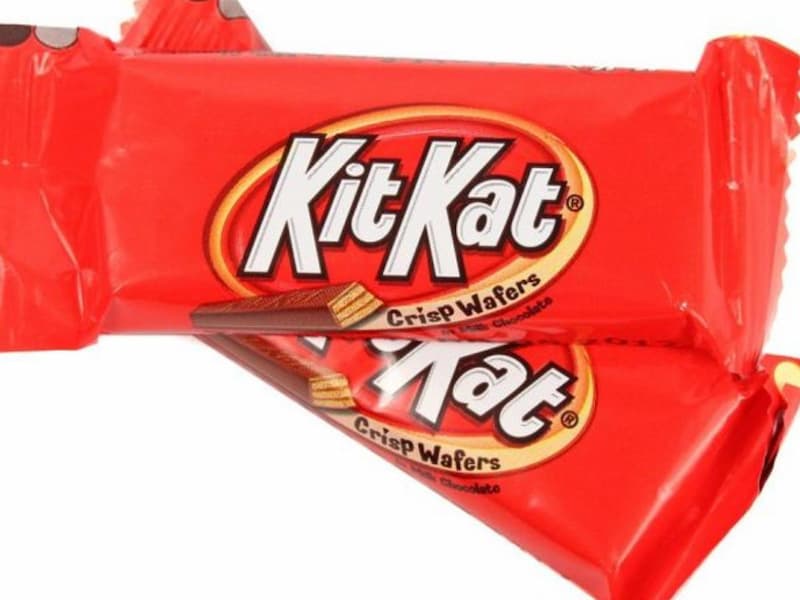
Are Kit Kats Vegan? No! Because…
Do many people like to eat kit kats? Are kit kats vegan? No!
Vegetarians can eat Kit Kat bars (both the original and mini versions), but vegans cannot. They include several dairy-based products made from animal products. However, there is a fantastic vegan alternative to the well-known candy bar, which we’ll talk about in this article.
A well-known candy bar called the Kit Kat is made of wafers that have been coated in chocolate. It’s a candy that everyone recognizes because it’s been around since the late 1980s. Many vegans who have adopted a 100% plant-based diet have grown up eating the candy because it has been around for such a long time. They are curious if they can continue to do so.
Here, we’ll discuss the various animal products currently present in Kit Kat bars before outlining any vegan substitutes currently available.
Table of Contents
Why Kit Kats Are Not Considered Vegan?
Milk Products are present in Kit Kats.
For use in confections and other food products, the food production industry separates the various naturally occurring components from milk.2
Whey and casein, two useful proteins made from milk, can be produced. The milk fat, which is what gives milk its creamy texture, and lactose, a simple sugar found in milk, round out the list of ingredients. Dry milk powder is just milk that has had the water (and occasionally the fat) removed.
Keep in mind that the H.B. produces Kit Kat bars. Nestlé in Europe and other regions, as well as the Reese Candy Company (a division of the Hershey Company) in the US. Therefore, depending on where the bar is made, the ingredients do change.
Are There Any Vegan Kit Kats Left?
The KitKat V is the only Kit Kat product that is vegan as of the time of writing, so once more we can provide a straightforward response. Who doesn’t want a vegan Kit Kat chunky, we hope and suspect that this will change. Second, these plant-based bad boys are currently only sold in four-finger packets, and because they taste fantastic and we lack much willpower, our waistlines are rapidly growing.
So, while the non-vegan Kit Kat selection is very varied, offering a variety of flavors, sizes, and styles, vegans must simply stick to the traditional four-finger variety. While this is an improvement over nothing, we sincerely hope that more will follow.
If dark chocolate Kit Kats are not vegan, you might be wondering why. Even though this bar does not contain milk chocolate, it does contain a number of ingredients that are milk-based or milk-derived, just like all the other bars that Nestle produces under the Kit Kat brand. We’ll go into more detail about this later.
What Are Kit Kats Made Of? Full Ingredients List
Have you ever wondered what exactly goes into making Kit Kats? If so, you have come to the right place! I’ll list every ingredient in the original Kit Kat bar below and explain which ones are problematic for vegans.
For your convenience, here is a brief overview of the ingredients:
Let’s go through the list now and address any questions you may have.
Cocoa Butter
Natural butter known as cocoa butter can be found inside cacao pods. The large seed pods are removed from the cacao tree when they are ripe and cracked open. The beans (which are actually seeds) are removed, dried, and cleaned to be processed into cocoa powder.
A layer of fatty, thick butter covers the beans. All-natural vegan lotions, cosmetics, and hair products as well as chocolate are made with this cocoa butter! It is completely organic, vegan, and very healthy for you.
Nonfat Milk
One of the primary ingredients in milk chocolate is nonfat milk. Sadly, it is a direct dairy product that originates from exploited, inhumanely treated cows in the current dairy industry.
Chocolate
A natural, vegan food made from dried and ground cocoa beans is called chocolate (cocoa powder). In chocolate candies, this is the main component! It’s quite bitter all by itself. But chocolate is a delicious treat when combined with a little sweetener and cocoa butter.
Palm Oil
A plant-based oil called palm oil is used to soften and thicken chocolate Kit Kats. Although palm oil is “plant-based,” most vegans try to avoid it for ethical reasons.
Large tracts of South American and Indonesian rainforests have been completely destroyed by palm oil farming, which is also to blame for the eradication of orangutans.
Sugar
All Kit Kat flavors and the majority of other candies contain sugar as their primary ingredient. Although some vegans eat sugar, many do not. This is due to the fact that most vegans disagree with the non-vegan filtration process that the refined white sugar used in most candy undergoes.
Raw cane sugar must go through bone char filters, which purify and concentrate the crystals, in order to transform natural organic cane sugar into white sugar. It goes without saying that doing this (however unintentionally) supports the meat industry, which is problematic for moral vegans.
Wheat Flour
The thin, crispy wafers at the core of every Kit Kat are made from wheat flour. Wheat flour is a product that is suitable for vegans and is created from dried and ground wheat fruit.
Milk Fat
The thick, fatty curdles that are removed from raw milk makeup milk fat. A thicker, creamier chocolate product is frequently produced using these. This item is obviously not vegan because it contains dairy.
Lactose From Milk
Milk naturally contains a sugar called lactose. Because it tastes good with milk chocolate, lactose sugar is frequently used in chocolate candies.
Soy Lecithin
A semi-natural additive made from processed soybeans is known as soy lecithin. It serves as an emulsifier and a natural preservative to prevent the separation of different ingredients.
PGPR
A chemical emulsifier made from organic fatty acids is called PGPR. It is combined with soy lecithin to form an emulsifier mixture that is frequently used in processed chocolate candies. The two emulsifiers work together to produce a less viscous, smoother chocolate.
Vanillin
To give Kit Kat’s milk chocolate a richer, more complex flavor, vanillin, a synthetic vanilla flavoring, is added. Additionally, a variety of other milk chocolate candies contain this flavoring.
Salt
The wafer dough at the center of each Kit Kat is made with salt. Salt fortifies the dough mixture, making it more consistent and firm.
Yeast
Also included in the wafer dough is yeast. It aids in the dough’s rise when added, causing air bubbles to form and giving the wafers a texture that is extra-crisp and airy. Yeast can also be deactivated to make a popular vegan seasoning called nutritional yeast!
Baking Soda
Another minor component used in the production of Kit Kat wafers is baking soda. It gives the dough a crispy texture and aids in rising. Baking soda is an organic chemical made of sodium and carbon, specifically sodium bicarbonate.

If You’re A Vegetarian, Are Kit Kats Okay?
You’ll be pleased to learn that many Nestle Kit Kat products are suitable for vegetarians because they only use milk and no other animal products. This is good news for those of you who follow a vegetarian diet.
Before consuming any product, please read the ingredient list carefully because they can vary from country to country and because businesses occasionally make sudden changes to their ingredient lists.
What About The Kit Kat V?
Yes, it is; in fact, we have tried it ourselves (six times and counting since we like to be thorough!) and it really is a brilliant example of a vegan version of a classic piece of confectionery. Even though it might be exaggerated to claim that Kit Kat’s #veganbreak marketing has completely revolutionized the internet or even just begun to scratch the surface of it, the KitKat V has received a lot of supportive comments using the hashtag.
Although we are obviously working from memory, we felt they were a really good “impersonation” of a standard KitKat. Having said that, we served them to our non-vegan tasters who concurred. Perhaps the flavor was very slightly different, but we are very confident that if you simply handed someone a KitKat V, they wouldn’t question it. And when we talk about a vegan alternative or version of something, that is actually the gold standard. So, kudos to KitKat V, and if you liked the original, we wholeheartedly recommend this product.
What Stores Sell Vegan Kit Kats?
Actually finding one took a lot of searching, and in the end we were forced to give up—at least by conventional means. There were simply no vegan KitKats to be found. Because of this, we contacted the manufacturer, Nestle, who informed us that Sainsbury’s is the only place to find them at least for the time being. Strange.
Anyway, once we knew this information, obtaining a KitKat V was simple. We visited Sainsbury’s. We do not know if this is a supply issue, an exclusivity period, or a trial, but we hope that they will soon be more widely available.
Conclusion
So, kit kats are not vegan. As you may know, since the milk used to make Kit Kats is regular milk from cows, they typically contain about 75% milk chocolate. As a result, they are not vegan. Although Nestle currently uses cow’s milk in their Kit Kat products, there may have been a chance that they had made this from oat, almond, or soy milk instead.

